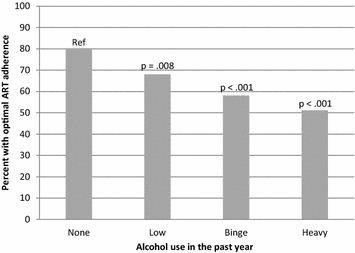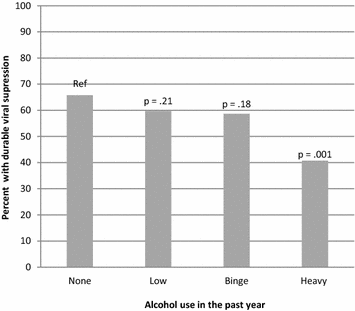Alcohol consumption patterns and HIV viral suppression among persons receiving HIV care in Florida: an observational study
- PMID: 28950912
- PMCID: PMC5615807
- DOI: 10.1186/s13722-017-0090-0
Alcohol consumption patterns and HIV viral suppression among persons receiving HIV care in Florida: an observational study
Abstract
Background: Alcohol consumption has been associated with poor antiretroviral therapy (ART) adherence but less is known about its relationship to HIV viral suppression, or whether certain drinking patterns have a stronger association than others. The objectives of this study were to determine the association of different patterns of alcohol consumption to HIV viral suppression and ART adherence, and to determine whether any associations of alcohol with HIV viral suppression were mediated by poor ART adherence.
Methods: This observational study used baseline data from 619 HIV+ participants, recruited across 8 clinical and community settings across Florida as part of the Florida Cohort from 2014 to 2016. Alcohol consumption was measured by self-report, and grouped into four categories: heavy drinking (>7/week for women or >14 drinks/week for men); binge, but not heavy drinking (≥4 or >5 drinks/occasion for women and men, respectively), low level drinking (neither heavy nor binge), and abstinence. Serum HIV RNA measurements were obtained from statewide HIV surveillance data, and durable viral suppression was defined as achieving HIV viral suppression (<200 copies/ml) at every assessment in the past 12 months.
Results: The majority of the 619 participants were male (63%) and aged 45 or greater (65%). The proportion of participants with heavy, binge, low-level drinking and abstinence was 9, 25, 37 and 30%, respectively. Optimal ART adherence (≥95%) was reported by 68%, and 60% achieved durable viral suppression. In multivariable analysis controlling for demographic factors, drug use, and homelessness, heavy drinking (compared to abstinence) was associated with increased odds of failing to achieve durable viral suppression (OR 2.16, 95% CI 1.08-4.32) whereas binge drinking alone was not significantly associated with this outcome (OR 1.04, 95% CI 0.64-1.70). Both heavy drinking and binge drinking were significantly associated with suboptimal ART adherence. Mediation analyses suggested that only a small proportion of the relationship between heavy drinking and suboptimal viral suppression was due to poor ART adherence.
Conclusions: Exceeding weekly recommended levels of alcohol consumption (heavy drinking) was significantly associated with poor HIV viral suppression and ART non-adherence, while binge drinking was associated with suboptimal ART adherence in this sample. Clinicians should attempt to address heavy drinking in their patients with HIV.
Keywords: ART adherence; Alcohol consumption; Binge drinking; HIV; Viral suppression.
Figures


References
-
- FACT SHEET: The national HIV/AIDS strategy: updated to 2020. whitehouse.gov. 2015 (cited 2015 Sept 30). https://www.whitehouse.gov/the-press-office/2015/07/30/fact-sheet-nation.... Accessed June 2017.
Publication types
MeSH terms
Substances
Grants and funding
LinkOut - more resources
Full Text Sources
Other Literature Sources
Medical
Miscellaneous

